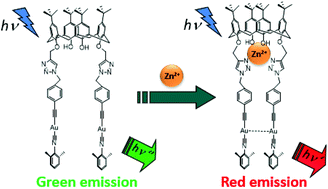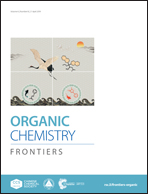Calixarene-based alkynyl-bridged gold(i) isocyanide and phosphine complexes as building motifs for the construction of chemosensors and supramolecular architectures†‡
Abstract
A series of calixarene-based alkynyl-bridged Au(I) isocyanide and phosphine complexes has been designed and synthesized. These complexes are found to exhibit intense emission in dichloromethane solution, in the solid state and in the glass state at 298 K and 77 K. The gold(I) isocyanide complexes with a triazolyl group as a receptor site have been shown to switch on a low-energy emission band upon addition of Zn2+ ions. The new low-energy emission band is ascribed to result from the switching on of the Au⋯Au interaction upon the binding of the Zn2+ ion that gives rise to a reduced HOMO–LUMO energy gap. Furthermore, an interesting supramolecular architecture of tetranuclear gold(I) phosphine stabilized by Au⋯Au interactions has been isolated. Short Au⋯Au distances are found in the X-ray crystal structure.

- This article is part of the themed collection: In celebration of Julius Rebek’s 75th Birthday


 Please wait while we load your content...
Please wait while we load your content...